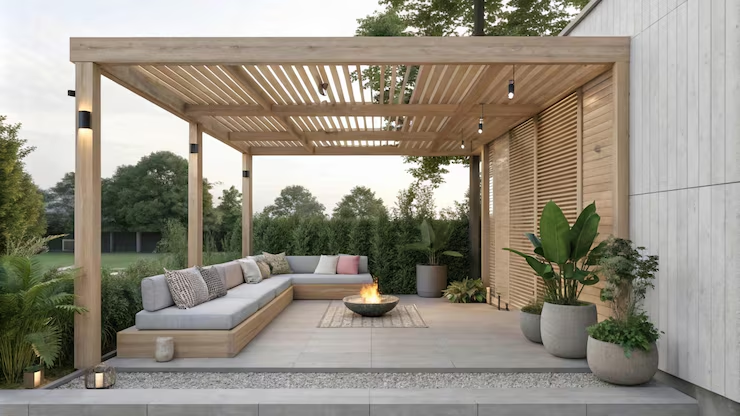You don’t need a sky-high budget to host a stylish event—discover how to find affordable tent rentals that look elegant, elevated, and unforgettable.
Durkin's Blog
How to Find Affordable Tent Rentals That Still Look Luxe
Everything You Need to Know About Pergolas: Styles, Benefits, and Buying Tips
November 17, 2025
Awnings
If you want to elevate your backyard or business exterior, pergolas are the perfect balance of beauty and function. They don’t just add style—they redefine how you use your outdoor space. These versatile structures create shade, comfort, and architectural character while extending your indoor living area into the outdoors.
Choosing the right pergola means understanding the different styles, benefits, and key buying factors that ensure you invest wisely and enjoy your outdoor retreat for years to come.
Top 10 Pergola Designs to Elevate Your Outdoor Living Space in 2026
November 14, 2025
Awnings
Create a stunning backyard retreat that blends luxury, comfort, and cutting-edge design. Discover the most innovative pergolas of 2026 and how they can redefine your outdoor living experience.
10 Best Pergola with Roof Ideas for a Sleek, Modern Outdoor Space
October 27, 2025
Awnings
If your outdoor area feels underwhelming or underused, the solution might be simpler than you think.
A pergola with roof doesn’t just offer shade — it completely transforms how you experience your backyard. Whether you want a cozy retreat or a space for entertaining, a modern pergola blends comfort, style, and structure in one elegant design.
With advanced features like retractable roofs and StruXure smart pergolas, homeowners across Connecticut are turning ordinary patios into all-season sanctuaries that elevate both lifestyle and home value.
10 Reasons People Love Pergola
October 20, 2025
Awnings
If you’ve ever admired a backyard that feels like a luxurious retreat — with cozy shade, beautiful design, and a welcoming atmosphere — chances are, it had a pergola. Homeowners across Connecticut are discovering the magic of these simple yet transformative structures. But what is a pergola, and why do people love them so much?
8 Creative Pergola Ideas to Transform Your Outdoor Space
October 13, 2025
Awnings
Looking to add comfort, charm, and personality to your backyard or patio? The right pergola design can turn even the simplest outdoor space into a breathtaking extension of your home. In fact, studies show that after upgrading their outdoor areas, 72% of homeowners spend more time relaxing — proving how the right environment can elevate both comfort and lifestyle.
Whether you’re exploring small patio pergola ideas or envisioning a grand backyard pergola for entertaining, these creative tips will help reimagine your space.
Pergola Durability in High Winds: Codes, Wind Limits, and Resistant Materials
October 6, 2025
Uncategorized
Pergolas bring shade, style, and comfort to outdoor spaces, but their durability in high winds is an important factor to consider. From regional building requirements to material strength and smart installation, several details play a role in how well a pergola stands up against storms. Knowing the limits and maintenance needs helps ensure long-term safety and performance.
Here are key insights on codes, wind limits, and materials that improve pergola durability in high winds.
How to Clean Mold Off Canvas Awnings: Easy Tips for a Fresh, Mold-Free Look
September 29, 2025
Awnings
Canvas awnings add shade, comfort, and style to outdoor spaces, but they can also become a target for mold, especially in damp or humid weather. Mold not only makes awnings look dirty and worn out, but it can also lead to health concerns if left untreated. In particular, black mold is a type of fungus that can trigger reactions in the immune system, making it important to deal with the problem quickly. Regular cleaning and a few simple steps can keep awnings looking fresh, strong, and safe.
How Much Is a Pergola? From Building Basics to StruXure Louvered Roof Costs
September 22, 2025
Awnings
A pergola is one of the most popular ways to upgrade an outdoor space, offering both shade and style. The cost can vary widely, from simple wooden structures to advanced systems with smart features. Factors such as size, materials, and whether it is a DIY kit or a professionally installed model all influence the total price. Many homeowners ask how much is a pergola, and the answer depends on the type selected and the level of customization.
Here are the key details that explain the range of pergola costs, from basic builds to high-end StruXure louvered roof systems.
Cool Comfort: Shade Pergola Ideas with Style and Function
September 15, 2025
Tents
Pergolas are a stylish and practical way to enhance outdoor spaces, offering structure, shade, and a natural gathering spot for relaxing or entertaining. With the right features—such as retractable canopies, climbing plants, or lighting—a pergola can seamlessly blend beauty and comfort.
Here are some stylish and functional pergola shade ideas to inspire the perfect outdoor setup.



















